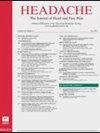Persistence, effectiveness, and tolerability of anti‐calcitonin gene–related peptide monoclonal antibodies in patients with chronic migraine
IF 5.4
2区 医学
Q1 CLINICAL NEUROLOGY
引用次数: 0
Abstract
ObjectiveTo evaluate, in patients with chronic migraine (CM) in real‐world conditions, the persistence, effectiveness, and tolerability of erenumab, fremanezumab, and galcanezumab anti‐calcitonin gene–related peptide (anti‐CGRP) monoclonal antibodies (mAbs) and the persistence and effects of switching.BackgroundAnti‐CGRP mAbs represent a novel therapeutic approach to the management of CM; however, real‐world data on persistence, effectiveness, and tolerability, especially after switching, are scarce.MethodsThis was a retrospective observational cohort study including all patients with CM treated with erenumab, fremanezumab, and/or galcanezumab in a tertiary hospital between January 2019 and December 2022. Treatment persistence was measured as the number of days between treatment start and end dates or the end of follow‐up and also as a percentage of persistent patients at 3, 6, and 12 months; effectiveness as a ≥50% reduction in monthly migraine days (MMD); and tolerability as the number and type of adverse events.ResultsIncluded were 281 patients (383 treatments) with CM (91.5% [257/281] female) receiving anti‐CGRP mAbs. Median (interquartile range [IQR]) treatment persistence was 267 (103–550) days. At 12 months, persistence was greater for the first (66.7%) compared to the second (49.8%) and third (37.2%) anti‐CGRP mAb treatments (hazard ratio [HR] = 1.93, 95% confidence interval [CI]: 1.35–2.74; HR = 2.75, 95% CI: 1.69–4.47, respectively). Persistence minimum observed median (IQR) was also greater for the first (291 [112–594] days) compared to both the second (188 [90–403] days;抗降钙素基因相关肽单克隆抗体在慢性偏头痛患者中的持续性、有效性和耐受性
目的评估在真实世界条件下慢性偏头痛(CM)患者使用erenumab、fremanezumab和galcanezumab抗降钙素基因相关肽(anti-CGRP)单克隆抗体(mAbs)的持续性、有效性和耐受性,以及换药后的持续性和效果。背景抗CGRP mAbs是治疗CM的一种新型治疗方法;然而,有关持续性、有效性和耐受性(尤其是转换后)的真实世界数据却很少。方法这是一项回顾性观察队列研究,包括2019年1月至2022年12月期间在一家三级医院接受erenumab、fremanezumab和/或galcanezumab治疗的所有CM患者。治疗持续性以治疗开始和结束日期或随访结束日期之间的天数来衡量,也以3个月、6个月和12个月时持续性患者的百分比来衡量;有效性以每月偏头痛天数(MMD)减少≥50%来衡量;耐受性以不良事件的数量和类型来衡量。结果纳入了281名接受抗CGRP mAbs治疗的CM患者(383次治疗)(91.5% [257/281]为女性)。治疗持续时间的中位数(四分位数间距[IQR])为267(103-550)天。12 个月时,第一次(66.7%)抗 CGRP mAb 治疗的持续率高于第二次(49.8%)和第三次(37.2%)抗 CGRP mAb 治疗的持续率(危险比 [HR] = 1.93,95% 置信区间 [CI]:1.35-2.74;HR = 1.35-2.74,95% 置信区间 [CI]:1.35-2.74):分别为 1.35-2.74; HR = 2.75, 95% CI: 1.69-4.47)。与第二次(188 [90-403] 天;p < 0.001)和第三次(167 [89-352] 天;p < 0.001)抗 CGRP mAb 治疗相比,第一次(291 [112-594] 天)的最低观察中位数(IQR)也更高。对于第一次抗 CGRP mAb 治疗,不同药物的持续时间没有差异。就第一次、第二次和第三次抗 CGRP mAb 治疗的疗效而言,3 个月时分别有 57.6%(117/203)、25.0%(11/44)和 11.8%(2/17)的患者 MMD 减少≥50%,6 个月时分别有 55.8%(87/156)、29.6%(8/27)和 12.5%(1/8)的患者 MMD 减少≥50%。12个月时,抗CGRP mAb疗法的疗效无明显差异。在耐受性方面,43 名患者(15.3%)报告了 55 例不良反应,大部分为轻微不良反应,仅有 14 名患者(5.0%)因此中断治疗。最常见的不良反应是便秘、注射部位反应和瘙痒。结论:我们的研究结果表明,由于疗效不佳或严重副作用而转用第二种治疗方法时,使用第一种抗 CGRP mAb 治疗方法的 12 个月治疗持续率较高。而在使用第二或第三种抗 CGRP 后,治疗的持续率较低。此外,就疗效而言,第一种抗CGRP治疗在MMD减少≥50%方面取得了更高的反应;然而,一些患者可能会从转换策略中获益。最后,抗CGRP mAbs的耐受性良好。需要进一步研究以确定从第一种抗CGRP mAb治疗转换后的反应预测因素。
本文章由计算机程序翻译,如有差异,请以英文原文为准。
求助全文
约1分钟内获得全文
求助全文
来源期刊

Headache
医学-临床神经学
CiteScore
9.40
自引率
10.00%
发文量
172
审稿时长
3-8 weeks
期刊介绍:
Headache publishes original articles on all aspects of head and face pain including communications on clinical and basic research, diagnosis and management, epidemiology, genetics, and pathophysiology of primary and secondary headaches, cranial neuralgias, and pains referred to the head and face. Monthly issues feature case reports, short communications, review articles, letters to the editor, and news items regarding AHS plus medicolegal and socioeconomic aspects of head pain. This is the official journal of the American Headache Society.
 求助内容:
求助内容: 应助结果提醒方式:
应助结果提醒方式:


